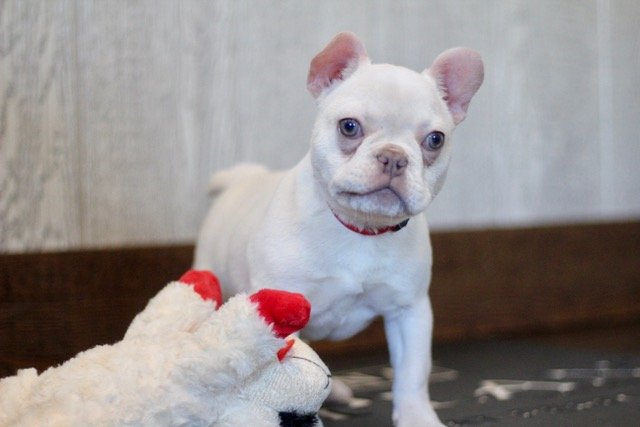Description
Breed Overview
The French Bulldog, with his large bat ears and even disposition, is one of the world’s most popular small-dog breeds. The Frenchie is playful, alert, adaptable, and completely irresistible. The French Bulldog resembles a Bulldog in miniature, except for the large, erect ‘bat ears’ that are the breed’s trademark feature. The head is large and square, with heavy wrinkles rolled above the extremely short nose. The body beneath the smooth, brilliant coat is compact and muscular. Dogs of few words, Frenchies don’t bark much but their alertness makes them excellent watchdogs. They happily adapt to life with singles, couples, or families, and do not require a lot of outdoor exercise. They get on well with other animals and enjoy making new friends of the human variety. It is no wonder that city folk from Paris to Peoria swear by this vastly amusing and companionable breed.
Because of their front-heavy structure, Frenchies cannot swim and should never be left unattended near a body of water. Like all flat-faced breeds, Frenchies are prone to breathing problems and do poorly in hot or humid weather. Frenchies occasionally have eye conditions such as cherry eye, juvenile cataracts, or entropion, and skin allergies and autoimmune skin disorders are also known to occur. A responsible breeder will take advantage of available tests to screen breeding stock for conditions that can affect the breed.
The Frenchie’s short coat sheds minimally. Weekly brushing with a medium-bristle brush, a rubber grooming mitt or tool, or a hound glove will help to remove shed hair and keep him looking his best. Brushing promotes new hair growth and distributes skin oils throughout the coat to help keep it healthy. A Frenchie’s facial folds should be kept clean and dry and his nails should be trimmed regularly.A short walk or outdoor play session with their owner each day should provide enough exercise to keep the French Bulldog in shape.
Early socialization and puppy training classes are recommended. Exposing the puppy to a wide variety of people, places, and situations will help him develop into a well-adjusted adult. Puppy training classes serve as part of the socialization process, promote good behavior, and help the owner learn to recognize and correct bad habits. Frenchies have big personalities and can need a fair amount of training to make them civilized companions. They can be stubborn, but at heart they’re people pleasers and therefore easy to train. The proper motivation (such as food) and making a game of the process will ensure their cooperation.
Frenchies are prone to obesity, which can damage their physical structure and puts them at higher risk for some of the breed’s health issues, so it is vital to watch their calorie intake and weight. If you choose to give your dog treats, do so in moderation.
Breed History
In the mid-1800s, a toy-size Bulldog found favor in some English cities, including Nottingham, then a center for lace making. The toy Bulldog became something of a mascot for Nottingham’s lace makers. This was the height of the Industrial Revolution in England, and such “cottage industries” as lace making were increasingly threatened. Many in the lace trade relocated to northern France, and of course, they brought their toy Bulldogs with them.
The little dogs became popular in the French countryside where lace makers settled. Over a span of decades, the toy Bulldogs were crossed with other breeds, perhaps terriers and, along the way, developed their now-famous bat ears. They were given the name Bouledogue Français.
By the end of the 19th century, the Frenchie’s popularity had spread across Europe and to America. American devotees of the early 1900s contributed to the breed by insisting that the bat ear, as opposed to the “rose ear,” was the correct Frenchie type. It is by this distinctive feature that the Frenchie is instantly recognizable the world over.








